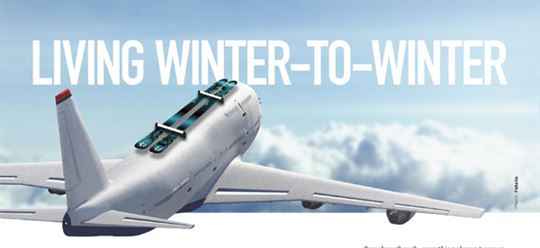There’s a fraternity of hemisphere-hopping ski instructors who don’t miss the long days of summer. MATT BARNES, a Ski Canada instruction editor, is one of them.

Winter to winter, travelling across the globe, hopping from one hemisphere to the other all in the chase of snow… It sounds grand, doesn’t it? To me it does—and it is—though not everyone shares my view. Typically when I explain that I teach skiing year-round, I receive one of two responses: you’re living the dream, or you’re completely mad. Maybe I’m both.
Aussies, Kiwis, Brits, Canadians, Italians, Japanese, Swiss, French, Danish, Austrians, Koreans and Americans all coming together with one thing in common—a love for winter. When I think of the people I’ve met along my hemisphere-hopping adventures, I’d say the ones who continue to live winter-to-winter, year after year, are all beautifully combining their madness with living the dream. There are those who have said for the last 10 seasons that “this will be the last time I skip summer” and then there are others who are determined to work more winters than years they have lived. (Yes, it is possible!)
There are always changes that go hand-in-hand with the perks of living winter-to-winter. One of the most noticeable for me is my accent and word choices. Being British but spending winters in Canada and Australia means I’ve had to consciously change the language I use (and subconsciously my accent) so that people can understand me. For example, in England we refer to our underwear as “pants.” What Canadians call their “pants” are actually “trousers” to the British. My first season in Canada, when someone started a chairlift conversation by asking what I thought about the park rats wearing baggy pants, I didn’t know how to respond.
Then, while in Australia, I learnt to shorten nearly every word, like “Straya” for the country. The afternoon became the “arvo” (not to be confused with “avo” or avocado) for example. Like in Britain (but not Canada) a cup of tea simply a “cuppa” and a “sarnie” or sandwich in the U.K. became a “sanger” down under. Confusion reigned until I’d adopted the hemisphere-hopping language that encompasses British, Australian and Canadian phrases. “Britstraladian” as another British-Australian-Canadian I met along the way liked to call it.
Obviously, changing hemispheres every six months means a lot of flying, and since there are about six weeks of downtime in between the seasons, usually time is on your hands. This means that a cheap flight that stops in Singapore then is redirected to Shanghai before a quick stop in Delhi are usually the ones picked to save a few extra dollars.
I consider myself to be a bit of a pro at packing my life into a 23-kg bag every six months. Luckily, since my life is skiing, it means packing is fairly simple. But I’ve had to try everything to get around excess baggage charges—coming close to having to wear my ski boots and helmet on board. I once spent half an hour arguing with diminutive-sized Chinese Airlines agents about their policy on ski bags that could only be 140 cm long. The fact that my already short 170-cm skis towered over them didn’t help. My avalanche gear confused the matter even more, and I found myself demonstrating backcountry survival techniques in the middle of a busy airport in front of a crowd of nervous Chinese men after they discovered my beacon, probe and shovel in the same bag.
Somehow though, everything always turns up at the other end and once you get back on snow with the equipment you’ve dragged across the world, everything seems to ski even sweeter.
Immigration laws and work permits are the thorn in the side of the lifestyle of working around the globe. After being told to just “marry a girl with the right passport…it will make your life easier” I quickly discovered this was something much easier said than done. Maintaining a long-distance relationship in a ski resort reminds me of maintaining my skis—without regular attention, love and care the edges become dull, the base turns dry and you’ll find there is an Italian race coach who knows how to do it a lot better than you do.
Do I miss summer? Sure I do, and it would be nice to get some colour on my whole body rather than just the bottom half of my face. I felt a goggle tan was always seen as a desirable quality at a ski resort; it shows everyone you’re on-hill a lot. I’ve met many skiers in Canada who wear the look with pride. It’s a different story when you’ve finished the southern hemisphere winter in September and you’re sporting an intense goggle tan in the northern hemisphere where people don’t understand why your face is two different shades.
As a wise man once told me: pursue your passion. I did that and I feel so lucky to have not only travelled around the world, but to have done it whilst doing something I truly love. But just loving skiing isn’t enough. You have to love the job you’re doing, too. For me, that has meant loving instructing: loving teaching beginners on the Magic Carpet how to stop just as much as teaching more advanced skiers how to push their limits while skiing hard down a steep mogul field or looking for powder in a back bowl. For others, it’s spending their nights perfectly smoothing out those runs in a groomer, or precisely tuning skis or serving the perfect beer at après ski.
For those of us who love our winter jobs, one winter a year just isn’t enough.